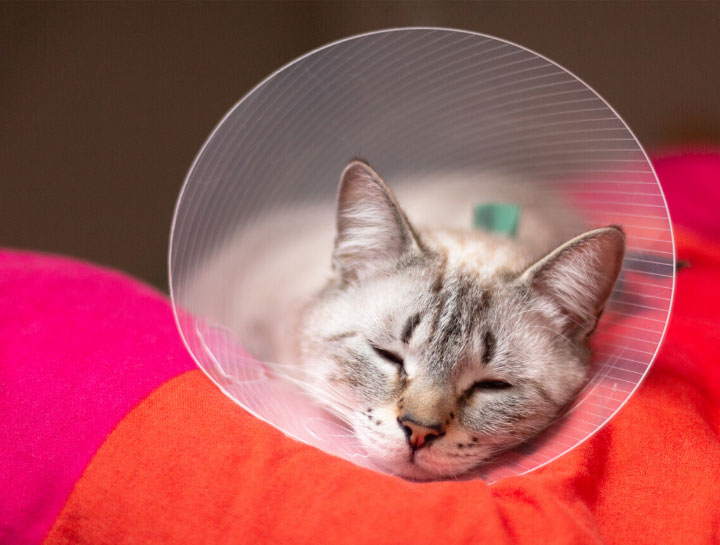Spay & Neuter Procedures
Help your pet live a long, healthy life.
Providing a loving environment for your pet, proper health care, and proper training will be the most influential benefit to maintaining a happy pet that fits into your family. Non-spayed females have an increased risk of cancer (uterine, ovarian, mammary) and an increased risk of a life-threatening uterine infection as they get older.
Information on Ovariohysterectomy (Spay) For Dogs and Cats
First, some basic reproductive terminology:
Spayed = a female cat or dog who has had both ovaries and uterus surgically removed, and is not capable of producing offspring.
Neutered = a male cat or dog who has had both testicles surgically removed, and is not capable of producing offspring. Also known as castration. Some refer to “neutered” as a male or female dog that has been surgically altered to render them sterile (testicles removed or ovaries removed, making them not capable of producing offspring).
Related terms: desexed, fixed, altered
Intact = not spayed or neutered, the animal has reproductive organs capable of producing offspring.
Queen = intact female cat
Tom = intact male cat
Bitch = intact female dog
Dog = intact male dog
Is spaying a major surgery?
Yes, because it involves surgically entering the abdomen, it is considered “major surgery”. This should not frighten pet owners, however, since this surgery is routinely performed, and is very safe. There are inherent risks with any anesthesia or surgical procedure, and talking over your fears and concerns with your veterinarian should help you understand any special risks that your pet may have. (For more on the actual surgery, see below.)
-
Myth #1 – I’ve heard that my pet should have a heat cycle first — she will be a better pet.
-
Myth #2 – I’ve heard that my pet should have a litter first — she will be a better pet.
These are two common misconceptions about spaying. You will do so much more for the health of your pet by spaying before the first heat. It has been reported that by doing so, you will reduce the chance of mammary (breast) cancer in your pet by as much as 97% over their lifetime. The chance of other reproductive cancers (uterine, ovarian, mammary) and uterine infection is eliminated in spayed animals. Even after the first heat, spaying will reduce the risks of certain cancers and eliminate reproductive organ disease.
Providing a loving environment for your pet, proper health care, and proper training will be the most influential benefit to maintaining a happy pet that fits into your family.
Non-spayed females have an increased risk of cancer (uterine, ovarian, mammary) and an increased risk of a life-threatening uterine infection as they get older.
Why does my vet want to do pre-surgery blood work on my pet?
Many veterinarians offer pre-anesthesia screening to their patients and may have you sign a waiver if you decline these blood tests. Why is this so important? It provides a way to assess kidney and liver function prior to undergoing anesthesia among other things. The liver and kidneys are the primary routes that the anesthetics are broken down and removed from the body. If they aren’t working well, then anesthesia may be more of a risk. There are many anesthetic agents available, and your veterinarian may also use the blood screening information to determine the best anesthetic protocol for your pet.
What happens during the surgery?
Your pet will be sedated and anesthetized so she won’t feel any pain or be aware of what is happening. Her breathing and heart rate will be closely monitored by the veterinary staff. The surgeon makes a small incision on her abdomen (belly area) and removes the two ovaries and uterus, usually just above the cervix. All vessels and tissues are ligated (tied off) to prevent bleeding and lessen the chances of post-operative bleeding or infection. Once the ovaries and uterus are removed, the surgeon begins the closure of the body wall, and skin — muscle, subcutaneous, and skin are sutured (stitched) back together. Your pet may have absorbable sutures, skin staples, or sutures visible in the skin that will need to be removed by your vet 10-14 days after surgery.
How soon will she be “back to normal”?
Most people are surprised at how quickly their pets recover from surgery (certainly much sooner than their human counterparts!) Most pets are up and alert shortly after surgery and after resting quietly for a day or two, most are back to their “normal” self. It is very important to restrict activity in those pets that are very active — too much activity can actually delay healing or cause post-surgical complications, such as dehiscence (opening of sutures) or bleeding.
If you have questions about getting your pet spayed or neutered, or you’d like to schedule an appointment, give us a call at (727) 784-0558 or request an appointment online.

